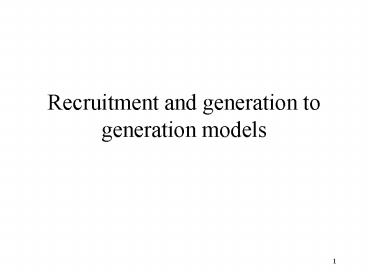Recruitment and generation to generation models - PowerPoint PPT Presentation
1 / 34
Title:
Recruitment and generation to generation models
Description:
In search of thresholds for recruitment overfishing. ICES Journal of Marine ... Lizard fish. 23. Process error estimation. 24. Process error. Beverton-Holt. 25 ... – PowerPoint PPT presentation
Number of Views:51
Avg rating:3.0/5.0
Title: Recruitment and generation to generation models
1
Recruitment and generation to generation models
2
Readings
Hilborn and Walters. Chapter 7 Myers, R. A., A.
A. Rosenberg, P. M. Mace, N. Barrowman, and V. R.
Restrepo. 1994. In search of thresholds for
recruitment overfishing. ICES Journal of Marine
Science. 51 191-205. Gilbert, D. J. 1997.
Towards a new recruitment paradigm for fish
stocks. Can. J. Fish. Aquat. Sci. 54 969-977.
3
Applications
- Fish semelparous species spawners to adults
- Fish recruitment of age 1
- Mammals/Birds recruitment of age 1
- Insects univoltine or other generation to
generation models
4
The recruitment process
- We usually define recruitment as the age or
size where we first detect the individuals with
whatever technology we employ - R(t) f(N(t-L))
- Basic elements, fecundity and survival
5
If no density dependence
Recruitment numbers times fecundity times
survival times environmental variability
Demo with spawner recruit simulation
6
There must be density dependence
- Otherwise the population would grow exponentially
or decline to extinction - This may not be true within poor habitats,
especially in meta population models - But in the poor habitats the population is
maintained by immigration and this is density
dependent
7
Mechanistic explanation
- unlimited habitat
- strict territoriality
- random egg deposition
- gradations in habitat quality
8
Unlimited habitat
9
Strict territoriality
10
Random egg deposition
11
Habitat gradations
12
Risk Sensitive Foraging
- The world is full of food, not because everyone
gets enough to eat, but because predation risk
keeps individuals from feeding as much as they
would like - Animals in micro habitats well protected from
predators will be the ones to feed enough to
survive
13
Observed relationships Skeena sockeye
14
Icelandic summer spawning herring
15
Other examples
- Sinclairs sterilized rabbits
- The baby boom of the 40s and 50s
16
Modeling recruitment
17
Principles
- Continuity no sharp jumps
- Stationarity shape of curve doesnt change over
time
18
Beverton Holt curve
19
Key assumptions of BH
- Survival depends upon the density of the cohort
at any time
cohort simulation.xls
20
Rickers model
21
Markov Skeena Sockeye
22
Lizard fish
23
Process error estimation
24
Process errorBeverton-Holt
25
Ricker fitting Monte-Carlo
26
Ricker likelihood profile
27
52 Monte carlo reps
28
Less contrast
29
Less contrast, high stock
30
Error in observations
31
Errors in observations
32
Final Points
- Contrast is important
- Bias induced by time series
- Bias induced by errors in observations
- Serial autocorrelation of residuals
- How to determine if environment is the cause?
33
Gilberts hypothesis
- Spawners generate recruits
- Not recruits generating spawners
34
(No Transcript)































